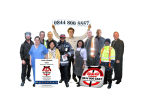Information
Our representatives will be happy to fight for your rights including workplace representation from an official should the need arise.
KNOW YOUR RIGHTS
Right to be accompanied
Workers have a statutory right (Employment Relations Act 1999 section 10) to be accompanied by a companion in disciplinary, grievance and appeal hearings.
The chosen companion may be a fellow worker, a trade union representative,
or an official employed by a trade union. A trade union
representative who is not an employed official must have been certified by their union as being competent to accompany a worker. The union of choice does not need to have a recognition agreement
with the employer for these types of meetings.
The companion should be allowed to address the hearing to put and sum up the workers case, respond on behalf of the worker to any views expressed at the meeting and confer with the worker during the hearing. The companion does not, however, have the right to answer questions on the worker’s behalf, address the hearing if the worker does not wish it or prevent the employer from explaining their case.
Direct Discrimination
Direct discrimination is when an employer blatantly treats people differently because of their race. This can include advertising jobs that are only for people of a certain race or paying one race more than others for doing the same job. This is not allowed and needs to be stopped as soon as it becomes an issue.
Indirect Discrimination
This type of discrimination is not quite so blunt but it includes rules or practices that put you at a disadvantage in the workplace because of your race. So it may be that your employer institutes a new dress code, for no particular reason such as health and safety, which discriminates against people from certain ethnic backgrounds. They may try to talk their way out of it and say it isn’t racist but if it puts you at a disadvantage because of your ethnicity, then it is. Rest assured, the Driver & General Union will be pleased to assist if you need any clarification.
The Driver & General union fights racism and plays a pivotal role in winning equality in the workplace. The union believes that the more members stand up against racism the more likely we will be able to instigate positive change. Every worker is entitled to be treated with fairness, dignity and respect.
Womens’ rights
Do you feel that you are working hard but for little recognition? The Driver & General Union is the voice that supports its female members and fights hard to improve the working conditions for mothers so that we can secure a better future for our children.
The Driver & General Union recognises that more can be done to achieve equal pay for women. The union realises that many women still earn less then men while having to work around home life commitments. Many have to balance work and child caring responsibilities which can be met with an aggressive or negative response from employers when requesting changes to working hours.
The Driver & General union recognises that women are a vital and significant section of our workforce and we make sure that their voice is heard and campaigns tirelessly on behalf of equal pay and child provision for women members.
It is time to put ourselves and our future first, for too long we have seen companies making huge profits as our standards of living drops and it becomes more difficult to juggle working hours with caring for the family.
The Driver & General Union seeks to improve the following:
Improved childcare arrangements
- The change to long working hours and establishing realistic work life balance
- The elimination of poor health and safety
- Promotion of mutual respect between women employees and their employers
The Driver & General Union works towards improving the standard of living for women members and their families. We want to enable families to achieve their goals and women to have the opportunity to develop their talents. All members should be able to enjoy fulfilling and rewarding work. Our commitment to you is that we will negotiate with employers a useful and beneficial agreement that secures improved working hours.
We will aim to end exploitation and discrimination of women in the workplace by improving employer awareness of the difficulties faced by employees in these difficult economic times.
Head Office
D&G Union
Kennedy House
Murray Road
St Pauls Cray
Orpington
Kent
BR5 3QY
08448 005 557
Membership rate: £11.45 pcm (a one off admin charge of £5.50 will be added to first month's membership fee).
Contact us today!
If you have any queries, please contact us:
08448 005 557
Or use our contact form.


